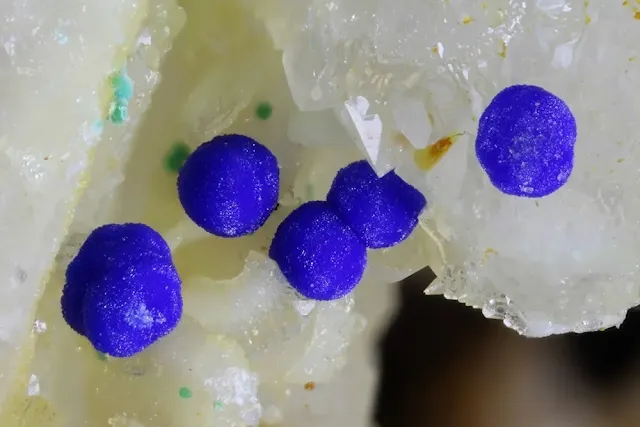Connellite: Mineral Information & Facts
Connellite is a rare hydrous copper chloro-sulfate mineral with the chemical formula Cu₁₉(OH)₃₂Cl₄·3H₂O. It crystallizes in the hexagonal system and typically forms as tufts of very delicate acicular crystals of a fine blue color.
Connellite is associated with other copper minerals of secondary origin, such as cuprite and malachite. It is a relatively uncommon mineral, and has been found in a few hundred locations worldwide, mostly in Europe and North America.
Connellite was first described in 1847 by Scottish chemist Arthur Connell. The type locality is Wheal Providence at Carbis Bay in Cornwall, England.
 |
| Connellite crystals from Madonna di Fucinaia, slag heaps, Campiglia Marittima, Livorno Province, Tuscany, Italy Photo: Henk Smeets/Tomeik Minerals. |
Named by James Dwight Dana in 1850 in honor of Arthur Connell [November 30, 1794, Edinburgh, Scotland - October 31, 1863], professor of chemistry at St Andrew's University, Edinburgh, Scotland, who first studied the mineral.
Connellite is a relatively soft mineral, with a Mohs hardness of 2.5 to 3. It is also quite brittle, and can easily be crushed or broken. Connellite is not particularly valuable as a gemstone, but it is sometimes collected by mineral enthusiasts.
Facts about connellite:
- It is a secondary mineral, which means that it forms from the weathering of other minerals.
- It is a hydrous mineral, which means that it contains water.
- It is a copper mineral, which means that it is composed of copper and other elements.
- It is a relatively rare mineral.
- It is sometimes collected by mineral enthusiasts.
 |
| Clara Mine, Freiburg Region, Baden-Württemberg, Germany. Photo: Reinhold |
Properties of Connellite
- Chemical formula: Cu₁₉(OH)₃₂Cl₄·3H₂O
Color is deep blue to a more rare, blue-green. - Luster is vitreous.
- Transparency: Specimens are mostly translucent to individual crystals being transparent.
- Crystal System is hexagonal; (6/m 2/m 2/m)
- Crystal Habits include acicular to fibrous crystals arranged in tufts, layers or radial aggregates.
- Cleavage is absent.
- Fracture is uneven.
- Hardness is 3
- Specific Gravity is approximately 3.4 - 3.5 (slightly above average for non-metallic minerals).
- Streak is blue.
- Associated Minerals include quartz, azurite, cuprite, brochantite, caledonite, atacamite, paratacamite, paramelaconite, malachite, cornubite and chalcophyllite, among others.
- Notable Occurrences are limited to the Wheal Gorland and other mines of the Wheal Providence, Cornwall, England; South Africa and the mines of Bisbee, New Cornelia, Mammoth-St Anthony and Copper Queen of Arizona, USA.
- Best Field Indicators are crystal habit, color, associations and locality.

%20(1).webp)






